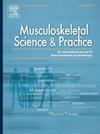慢性非特异性腰痛的脑结构和功能改变:一项病例对照研究
IF 2.2
3区 医学
Q1 REHABILITATION
引用次数: 0
摘要
目的探讨慢性非特异性腰痛(CNLBP)的临床症状及相关心理社会因素与大脑结构和功能改变的关系。本研究旨在确定CNLBP患者的灰质体积(GMV)的变化,并检查特定脑区静息状态功能连接(rsFC)的变化。方法本研究纳入30例CNLBP患者和30例健康对照者,进行临床评估和磁共振成像扫描。基于体素的形态学分析分析了CNLBP患者大脑区域的GMV变化,这些区域被定义为全脑rsFC分析的兴趣区域。偏相关分析和中介分析阐明了CNLBP的中枢神经机制。结果CNLBP患者疼痛严重程度与焦虑(P = 0.042)、抑郁(P < 0.001)、疼痛灾难化(P < 0.001)相关,与焦虑(P = 0.002)相关。左侧中央前回、舌回和右侧小脑区GMV减少。在小脑-丘脑-中央前网络(P < 0.001)和边缘系统(P < 0.001)中发现rsFC改变。偏相关分析显示,这些变化与CNLBP的临床症状相关(P < 0.05)。中介分析显示CNLBP患者BDI-II评分的严重程度可通过中央前回和小脑的rsFC间接介导(P < 0.05)。结论CNLBP患者的疼痛强度和躯体功能障碍与焦虑、抑郁、疼痛灾难化等心理社会因素有关。在这种情况下,大脑结构和功能的广泛变化可能有助于更好地理解CNLBP及其相关的社会心理因素。本文章由计算机程序翻译,如有差异,请以英文原文为准。
Brain structural and functional alterations in chronic non-specific low back pain: A case-control study
Objective
The relationship between clinical symptoms and associated psychosocial factors of chronic non-specific low back pain (CNLBP) and changes in brain structure and function remains unclear. This study aims to identify changes in gray matter volume (GMV) in patients with CNLBP and to examine changes in resting-state functional connectivity (rsFC) in specific brain regions.
Methods
This study included 30 CNLBP patients and 30 healthy controls, who underwent clinical assessments and magnetic resonance imaging scans. Voxel-based morphometry analyzed GMV changes in CNLBP patients' brain regions, which were defined as regions of interest for whole-brain rsFC analysis. Partial correlation and mediation analyses elucidated the central nervous mechanisms of CNLBP.
Results
In CNLBP patients, pain severity is associated with anxiety (P = 0.042), depression (P < 0.001), and pain catastrophizing (P < 0.001), while disability is associated with anxiety (P = 0.002). Reduced GMV was observed in the left precentral gyrus, lingual gyrus, and right cerebellum_Crus1. Altered rsFC was found in the cerebellum-thalamus-precentral network (P < 0.001) and limbic system (P < 0.001). Partial correlation analysis revealed that these changes were associated with clinical symptoms of CNLBP (P < 0.05). Mediation analysis revealed that the severity of BDI-II scores in CNLBP was indirectly mediated by rsFC in the precentral gyrus and cerebellum (P < 0.05).
Conclusions
This study found that the pain intensity and physical dysfunction in CNLBP patients are associated with psychosocial factors, such as anxiety, depression, and pain catastrophizing. In this context, widespread change in brain structure and function may contribute to a better understanding of CNLBP and its associated psychosocial factors.
求助全文
通过发布文献求助,成功后即可免费获取论文全文。
去求助
来源期刊

Musculoskeletal Science and Practice
Health Professions-Physical Therapy, Sports Therapy and Rehabilitation
CiteScore
4.10
自引率
8.70%
发文量
152
审稿时长
48 days
期刊介绍:
Musculoskeletal Science & Practice, international journal of musculoskeletal physiotherapy, is a peer-reviewed international journal (previously Manual Therapy), publishing high quality original research, review and Masterclass articles that contribute to improving the clinical understanding of appropriate care processes for musculoskeletal disorders. The journal publishes articles that influence or add to the body of evidence on diagnostic and therapeutic processes, patient centered care, guidelines for musculoskeletal therapeutics and theoretical models that support developments in assessment, diagnosis, clinical reasoning and interventions.
 求助内容:
求助内容: 应助结果提醒方式:
应助结果提醒方式:


